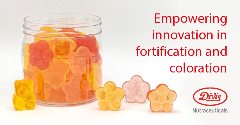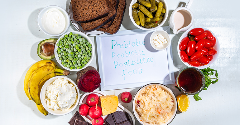News
What trends are driving the European food and drink industry?
24 Mar 2022Five evolving consumer trends are influencing food and drink development in the EU, spurring new formulation discoveries, product launches and communication campaigns, according to trade association, FoodDrinkEurope.
Taste (45%), the safety of food (42%) and cost (40%) are the leading factors affecting Europeans’ food purchases, according to the Data & Trends, EU Food and Drink Industry 2021 report, published by the trade association, FoodDrinkEurope.

In addition, developments in the food and drink industry are primarily driven by five factors, a spokesperson for FoodDrinkEurope says: “Pleasure, health, physicality, convenience, and ethics.”
Ethics, in particular, including the product’s environmental footprint, are increasingly essential drivers, the EU’s food industry confederation FoodDrinkEurope says, as the industry looks to reduce the environmental impact of food and drink and the processes that make them.
Making sustainable food choices
Sustainability within a diet is a significant consideration influencing European food and drink consumers today. Two-thirds of European consumers said they eat a healthy and sustainable diet most of the time, according to European Commission figures referenced by FoodDrinkEurope in its report.
For consumers, eating a variety of different foods (58%) and eating more fruit and vegetables (58%) are important factors in their pursuit of a sustainable diet. Factors that would encourage consumers to eat healthier and more sustainable diets include the affordability of healthier and more sustainable products (49%), having more choices where they typically shop (45%) and clearer information about a product’s environmental footprint (41%), the report reveals.
Supply chain challenge: working towards a sustainable food future
“Working towards more sustainable food systems is a shared responsibility of all actors in the food chain from farm to fork, whether it be farmers adopting more regenerative agricultural practices or consumers making a conscious change in their diets,” says the spokesperson for the trade association.
At the industry level, food and drink manufacturers currently engage in a variety of measures to improve their environmental footprint, the report outlines, including reducing carbon emissions, unlocking a circular economy, and developing more sustainable packaging.
To demonstrate how the EU food and drink industry is committed to achieving more sustainable food systems, in 2021, the industry signed up to the EU Code of Conduct on Responsible Food Business and Marketing Practices. The Code of Conduct has seen companies sign with concrete commitments to improve their environmental footprint. Since then, the Code has grown to 100-plus signatories and continues to grow every month, FoodDrinkEurope says.
The time is ripe for new developments
“The food sector is one of the most thrilling areas for innovation,” says the spokesperson. However, there are challenges such as climate change, demographic changes, malnutrition, food security, or food waste that require new developments to come up with solutions, he says.
Multiple sources reflect how the food industry explores new developments in Europe, FoodDrinkEurope says. It recommends the European Technology Platform (ETP) ‘Food for Life’ Strategic Research and Innovation Agenda (SRIA) and Innovation Action Plan (IAP) for more information on discoveries in food and drink.
“Each consumer (or customer) makes a conscious decision when they choose to buy one product or another, which means the life or death of any business,” says the spokesperson. As a result, many food businesses need to continuously consider those drivers and what will be the consumer’s behaviour in the future.
Achieving new food and drink goals
Talking about how new developments occur, the spokesperson says: “It does not come spontaneously to any business or company—it requires knowledge, research, scale-up of ideas, trials, and finally, consumer acceptance.” It is considered a complex process that requires investment and time and, in many cases, it also requires collaboration between companies, research providers and institutions, he adds.
“That is why for pre-competitive research and innovation, public-private partnerships are preferred to capitalise on all the required inputs for innovation that have a positive impact on society,” says the spokesperson.
Most new ideas that are implemented and reach the market try to satisfy consumer demand. Companies will try to bring ideas and products that create new trends in some cases. The spokesperson says: “This however is a risk for companies that work with large volumes and that is why this type of innovation (trend makers) is most favourable at a small scale within small and medium enterprises (SMEs) or startups.” The EIT-Food entrepreneurship programme celebrates ideas and launches by small-medium enterprises (SMEs).
There are many pathways taking place that the consumer might not perceive directly, “Reformulation of recipes at industrial level, changes in factories making efficiency savings, changes in energy use, improvements in food waste, packaging solutions for recyclability or biodegradability are some examples,” the spokesperson says.
Fit 4 Food 2030 is a multi-actor network mobilising a wide variety of stakeholders throughout Europe to strengthen R&D. It depicts current developments, detailing how research and development (R&D) is implemented in the sector.
Related news

Oat Barista: Innovation for game-changing beverages
20 Nov 2025
Oat Barista is a clean label, sustainable, and innovative drink base specifically designed to create the perfect foam in one single ingredient.
Read more
Nitrites: Pressure grows on UK to follow EU’s lead
20 Nov 2025
Pressure is growing on the UK to follow the EU’s lead after the bloc revised its regulations on the permitted levels of nitrites and nitrates in cured meats.
Read more
Empowering innovation in fortification and colouration
13 Nov 2025
Divi’s Nutraceuticals offers a large portfolio of innovative, high-quality ingredients for foods, beverages, and supplements, with bespoke solutions and expert support for product success.
Read more
Danone highlights digestive health as potential ‘tipping point’ for food industry
13 Nov 2025
Danone is betting on a food industry “tipping point” that will bloat the market for healthy products, particularly those related to gut health.
Read more
Standing Ovation and Bel scale up casein production from dairy co-products
11 Nov 2025
Foodtech company Standing Ovation has partnered with cheese specialist Bel Group to manufacture dairy serums for industrial-scale casein production via precision fermentation.
Read more
AI attraction means foodtech startups must ‘prove’ rather than ‘promise’
4 Nov 2025
Reports suggest that artificial intelligence (AI) is sucking investment from foodtech and agritech, but investors say the picture is complicated.
Read more
Will postbiotics become the go-to functional ingredient?
3 Nov 2025
Postbiotics show significant promise for the functional foods market due to their safety profile and beneficial bioactive properties, research suggests.
Read more
Meet the finalists of the Fi Europe Innovation Awards 2025
31 Oct 2025
Who made it to the shortlist of the Fi Europe Innovation Awards 2025? Read about the 23 companies making food and drink products healthier and manufacturing processes more efficient.
Read more
Penguin and Club bars no longer classed as chocolate
30 Oct 2025
Penguin and Club bars can no longer be classified as chocolate after the pladis-owned McVitie’s brands turned to cheaper alternatives amid the ongoing cocoa crisis.
Read more
Shorter drying time, sweeter success!
30 Oct 2025
Curious about cost-effective, sustainable and delicious candy making? Stefan Wessel reveals how Avebe’s solutions reduce drying time and energy use by up to 50%.
Read more